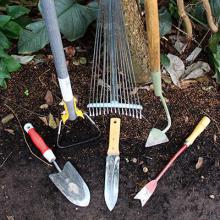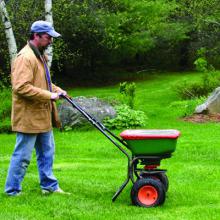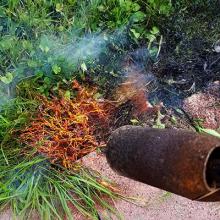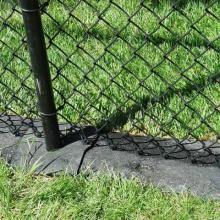
Playgrounds are unique areas in which to manage weeds because they are composed of several different environments and landscape features. Several different management strategies must be used due to this environment's varied nature.
This page will briefly discuss weed management practices relevant to playgrounds. For more information on weed management in a particular environment, please visit its respective page.
Environments
Mulch
Traditional mulch materials, such as wood bark and wood chips, often underlay play structures in playgrounds. Deep layers of material, which are used as a safety cushion for falls, are often deep enough to severely limit weed growth and establishment. Although weed control is generally achieved by the mulch alone, this can be supplemented by:
- Adding material to maintain a sufficient mulch depth.
- Regularly raking to uproot young weeds.
- Using hand tools, such as hula hoes, to cut and uproot established weeds.
Flame weeding should not be used in areas covered with organic mulch as mulch can pose a fire risk.
Grass
Though grass is another common playground ground cover, it is a difficult type of ground cover to maintain especially in high traffic and shady areas. If possible, consider alternative ground covers such as wood back, sand, and fine gravel.
The first defense against weeds is a healthy lawn. Grass selection is essential to well performing turf. Generally, cool-season grasses are better suited to the climate of New York. Weakened lawns are more vulnerable to weed establishment and proliferation. The severity of many weed problems can be limited by proper lawn care and other preventive measures.
Mowing Height
Mowing too low can increase weed pressure and weaken turf. Use a mowing height of at least 3 inches.
Proper fertilization
Proper timing of fertilization can help turf while limiting its benefits to surrounding weeds. In cool-season plantings:
- Avoid applying fertilizer in the summer.
- Fertilize in early fall if fertilizing annually. If fertilizing twice a year, apply fertilizer in early fall and late spring.
- Do not fertilize between December 1 and April 1. Under the NYS Nutrient Runoff Law, it is illegal to fertilize during this period in NY.
- Do not apply more than 1lb N/1000 sqft per application.
Overseeding
Weeds can be particularly problematic in thinned out areas of grass. This can be rectified by overseeding the area. Repetitive overseeding is the repeated application of grass seed over an existing lawn or grassy area. To learn more about repetitive overseeding, please visit its section on the Playing Fields page.
Mowing
In addition to being a key part of turf maintenance, mowing is a very effective weed control strategy especially for broadleaf weeds. In areas along fence lines and borders, mow strips can be installed. This allows a mower to cut weeds in these hard to reach areas, thus eliminating the need for string trimming.
String trimmer
String trimmers are particularly useful for cutting weeds and grass around play structure posts, along fences, and in other tight spaces. A string trimmer is a dangerous piece of equipment so great care should be taken when operating it. For more information about using a string trimmer, please visit its section of the Mechanical Control page
Hard Surfaces
Though hard surfaces such as cement, concrete, and pavement are often overlooked, weeds can become a major issue in these areas if not managed. Weeds grow very easily in gaps in hard surfaces which include joints, cracks, and depression in which soil is allowed to settle. To manage weeds in hard surfaces:
- Seal cracks and fill joints between bricks and paver.
- Regularly sweep to minimize soil accumulation.
- Remove weeds before they go to seed to minimize seed rain.
- Use tools to remove weed from joints and other crevices.
- Flame weed to control broadleaf weeds.
Gravel
Gravel is another commonly used material for playgroun ground cover. The gravel layer is usually thick enough to severely limit weed growth and establishment. Although weed control is generally achieved by gravel alone, this can be supplemented by:
- Regularly raking to limit soil accumulation and dislodge any establishing weeds.
- Maintaining a thick layer of gravel.




